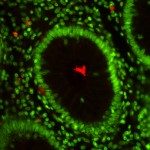Link to Pubmed [PMID] – 8478058
Infect. Immun. 1993 May;61(5):1707-14
The Shigella flexneri invasion process requires the synthesis of the Ipa proteins and their secretion by specific factors encoded by the mxi and spa genes, which are clustered upstream from the ipa operon. We report here the characterization of the ipgD, ipgE, and ipgF genes, which are located in the 5′ end of the mxi locus. Analysis of IpgF-PhoA fusions endowed with high levels of alkaline phosphatase activity confirmed the functionality of a classical signal sequence detected in the sequence of IpgF. The ipgD and ipgF genes were each inactivated on the large virulence plasmid by insertion of a nonpolar cassette; each of the ipgD and ipgF mutants thus constructed showed the same invasive phenotype as the wild-type strain and was able to provoke keratoconjunctivitis in guinea pigs. It thus appears that two genes located at the ipa-proximal part of the mxi locus are not directly involved in invasion. Analysis of concentrated culture supernatants of the wild-type and ipgD strains indicated that secretion of one polypeptide, whose size was consistent with that predicted for the IpgD protein (60 kDa), was abolished in the ipgD mutant.
